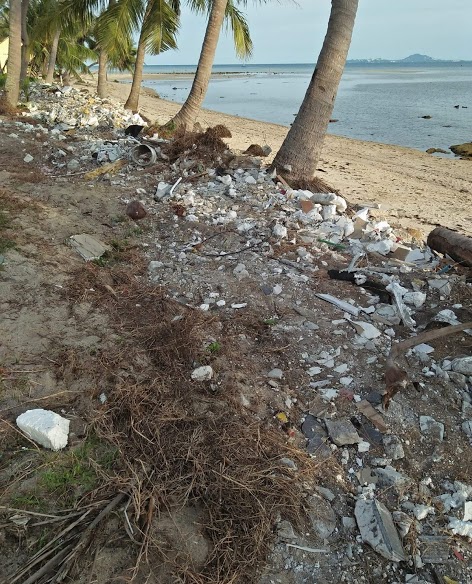
Eco Assessments & Action
Periodically EcoThailand undertakes (either as EcoThailand initiated or from external requests or contracts), EcoAssessments – an independent review of a specific site within the Gulf of Thailand.
Case Study: Eco Assessment and emergency action by EcoThailand on industrial dumping at a beach site, Baan Tai, Koh Phangan
It was brought to EcoThailands attention by a concerned local resident that industrial waste, including styrofoam, fibre glass insulation, gyproc boarding, concrete block, aluminium conduiting etc had been dumped at the beachside border of a private land plot (see attached video and photos) along a 50m stretch of beachfront. It was clear from the associated signage and papers that the materials originated from an island retail outlet.
Although on privately owned land there appeared to be a high likelyhood of washdown of materials onto the beach and into the sea during high tides or stormy weather, in addition to the unsightly nature, clearly visible from the beach.

EcoThailand undertook to inform the appropriate Tessabaan departments and the relevant retail outlet, providing a description, site identification and photographic evidence provided by both the resident and EcoThailand.
Both Tessabaan and the retailer acted swiftly in visiting the site and determined how the materials had been deposited.
Tessabaan issued instruction that the materials were to be removed within a 2 day period, which the retail outlet complied with fully, materials being removed from site and residual material buried under earth.
We would like to thank all involved, both resident, Tessabaan and the retail company, for swift and effective action.
Should inappropriate dumping be observed on the islands in future, the correct Tessabaan Departments to contact for Koh Phangan, Koh Samui or Koh Tao to request an assessment, and action are:
Koh Phangan (there are 3 municipalities on the island… Try to identify the correct one, failing that contact all 3):
Eco Assessment at Haad Rin – 1/4/18, 7.00 am after Full Moon Party.

The assessment was undertaken by members of EcoThailand, Provincial Natural Resources and Environment Officers, and Regional Environmental Office 14 Officers for report to the Haad Rin Association.
The beach area was visibly assessed throughout its full length, the in water debris was also visually assessed at a 10m distance from the shoreline over a length of 50m, situated at the central beach party site (Cactus). Water depth was approximately 0.2-0.5m.

Overall the beach was quite heavily littered with the expected debris. Even at this early hour, and the residue of the party still in progress, staff from the beach bars and contractors were rapidly clearing the macro debris (glass bottles, buckets, plastic bottles, cups and many straws). The collected materials were placed in piles for later removal by pickup. Later in the day the Haad Rin Association beach cleaning sifting machine passes over the beach removing residual macro plastic and smaller items (bottle caps, cigarette butts etc). Before the end of the day the beach has been fully cleared and cleaned and is again ready as a tourist beach venue with good overall general cleanliness.
Several party attendees were seen collecting trash and positioning at the dump sites for pickup … good on them.

The in water assessment revealed a surprisingly low level of underwater debris. Over the 50m review stretch only 4 submerged straws and a submerged plastic bucket were seen. Several tens of small paper items were observed. No glass bottles were seen, however other people in the water reported finding several glass bottles.
On the surface over the same extent of beach several 10’s of floating straws, several plastic bottles and a plastic bucket were seen.
The sea conditions on the day were calm and a low water tide, which may have contributed to the relatively low levels of beach debris entering the sea. We would hope to undertake additional investigations under different sea conditions at a future date.
All things considered, from an environmental pollution perspective, and bearing in mind the size of the Phangan Full Moon Party, there appears to be limited environmental pollution and incursion. This is probably a reflection of the many years of experience of the FMP beach businesses and the Haad Rin Association in dealing with a major beach party event. Further monitoring of the post party activities and particularly sea wash off, under different weather and sea conditions, is warranted.
Potential improvements will be assessed for future discussion, notably possible use of paper straws rather than plastic, other plastic replacements (biodegradable buckets, food containers etc), improved party attendee education and awareness (possibly through DJ involvement and announcements not to throw plastic and glass onto the beach), improved segregation of waste both during the party and at the collection time prior to disposal, so aiding the recycling organisations.
